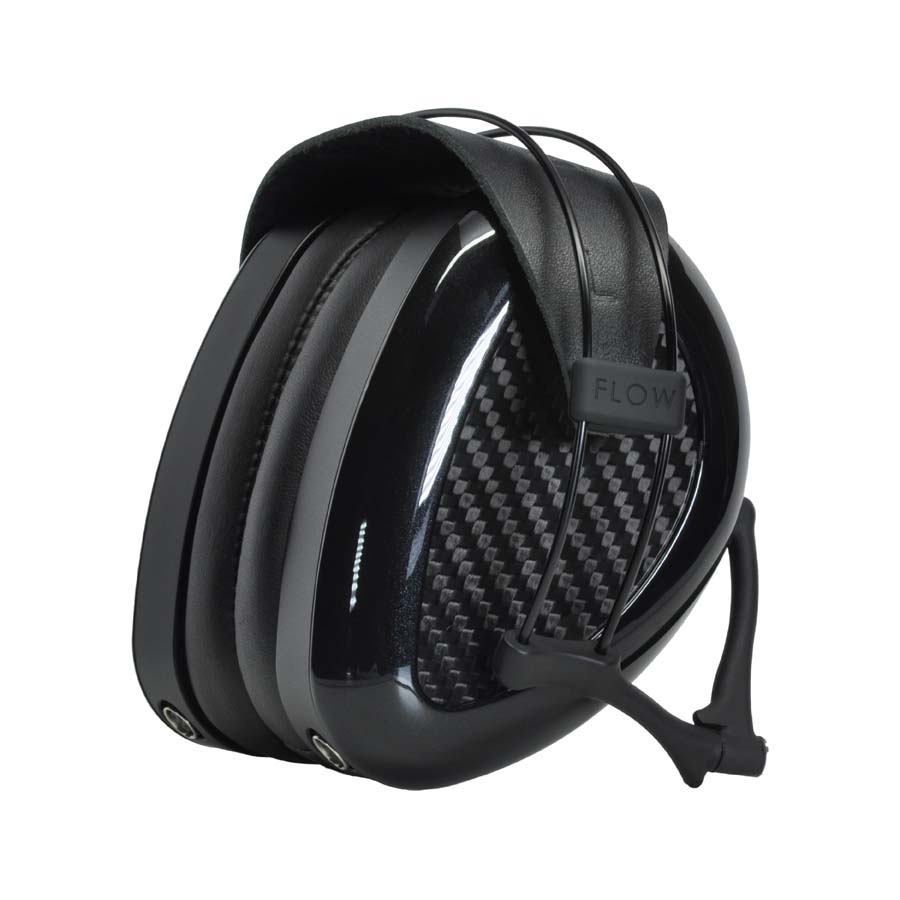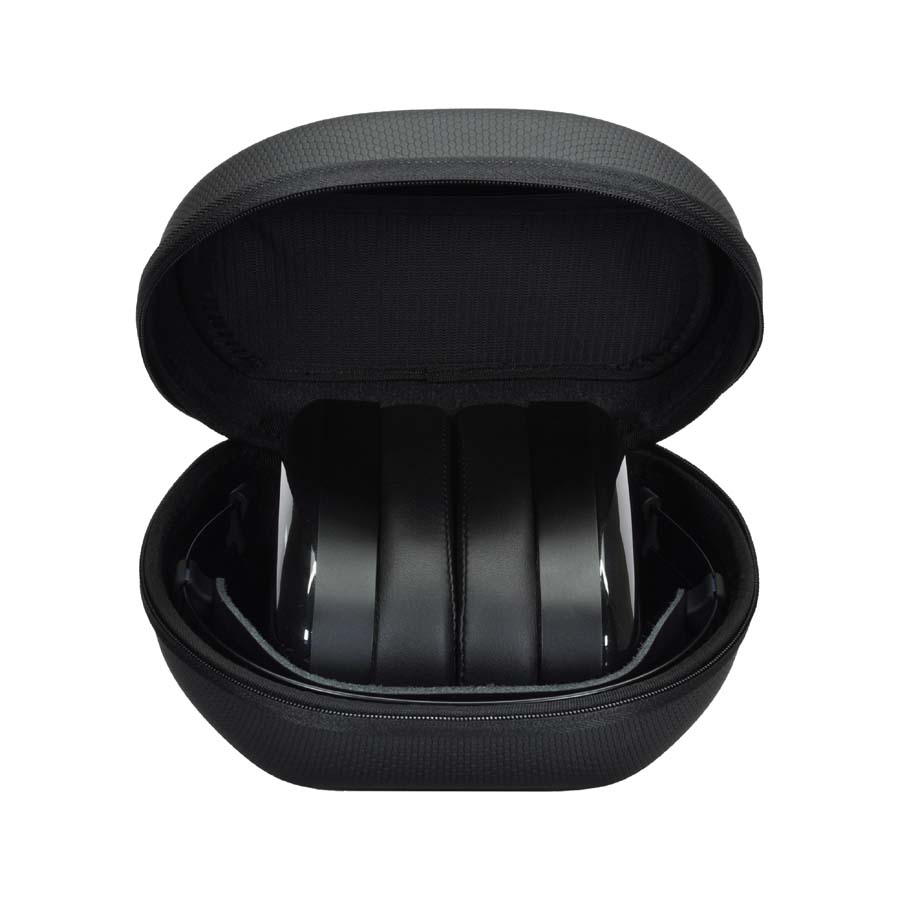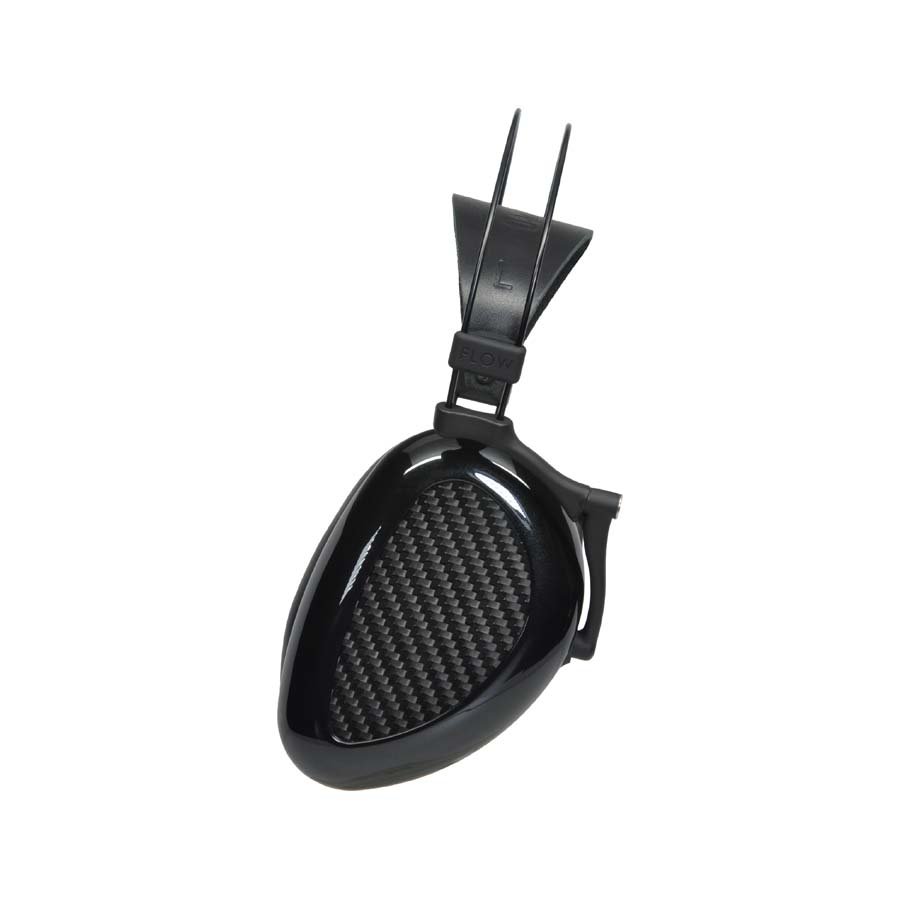DAN CLARKE ÆON 2 NOIRE HEADPHONE REVIEW
Dan Clarke Æon 2 Noire headphones are distributed in the UK by Electromod and cost £899, somewhat less than the brand’s recently launched flagship Stealth headphones costing $3999. Janine Elliot takes a listen to these relatively budget-conscious, yet high-end planar headphones.

There’s a modern and distinctive shape to the Dan Clarke Æon 2 Noire headphones.
I have followed Mr Speaker’s ear speakers with great interest over the years, especially the Ether series when it came out. He momentarily disappeared from radar and once he realised what his name was, came out as Dan Clarke Audio, I have to say a much better title since the old name could be a little confusing being a manufacturer of headphones. With great planar products appearing over the years and having previously heard the Æon 2 I wondered if its upgrade, the closed-back “Noire”, could get any better. As in the previous models, it uses the distinctive teardrop shape and utilizes the same excellent 62mm x 34mm planar driver as seen in the elder models.
CONSTRUCTION
As with all products from DCA, the construction is impeccable – this headphone was hand-built and tested in San Diego, California. The Æon 2 Noire is almost identical to the established Aeon 2 range, though this time is flanked unsurprisingly in a bright metallic black body, and coming in as a closed-back headphone. The headband is made of leather. The super-efficient textured transducer is also very lightweight, using the second generation Trueflow design, allowing more airflow through the motor, and hence more detailed sound. The V-Planar driver is designed to give superior bass end and improved diaphragm stability with its textured surface. The Noire can be bought in a selection of cable choices, from 4-pin XLR, regular 3.5mm and optional upgrade to VIVO silver-plated OFC leads.
COLLAPSIBLE
Unlike the earlier Æon Flow, what makes the Æon 2 and Æon 2 Noire so distinctive, and very useful, is that the headphones can be folded into half their size (for carrying about in the supplied box) meaning the full-size headphone can be stored in a handbag or rucksack. They weigh in at under 330g, around half the weight of the Audeze LCD 2 (598g), and although it might not be the lightest of all full-size headphones they are still incredibly lightweight and made long listening sessions a doddle. Keeping that weight down was the carbon fibre and the use of a thin Nitonel framework to hold the headphones on your head. Nitonel, by the way, is a mixture of nickel and titanium, a stretchy memory metal as used in teeth braces. The leather strap slides up and down on it for you to get the perfect fit. These are such comfortable headphones!

The Dan Clarke Æon 2 Noire collapse into a neat and portable package.
THE HARMON CURVE
The main difference between the Noire and the Æon 2 is evident on the front inside of the Japanese protein leather earpad. Here a fenestrated (perforated) finish is designed to create a “Harmon Curve” sound. This aims to create a frequency response matching the ideal headphone characteristics, led by Dr Sean Olive at Harman International in 2013. This curve gently accentuates the bass and treble. As the result will be a slightly recessed mid it brings forward and makes wider the soundstage, creating a very natural sound.

Dan Clarke Æon 2 Noire headphones in their case.
PADS
That treble boost was particularly noticed by Dan Clarke, so each Noire comes complete with a selection of material filters, which can be used singularly or in combination to get the ideal sound. Acting like a tone control, the purchaser is able to tune the headphones to match their headphone amp. Some DAPS won’t be powerful enough to play these at ear-blastingly high listening levels, so for this review I used four different headphone amps.
SOUND
For my tests, I used the iFi xCan and Slee portable headphone amplifiers, and the Slee and Brocksieper units with audio supplied by my Fiio DAP and Manley Steelhead phono-stage. Luckily my review sample was almost run in for proper use.
That Harmon curve was certainly noted in the playback of music. My initial findings on the Noire were of a bright top end. OK, I could filter it down using the “tuning materials” – which worked exceptionally well – but my argument is that just as we have moved away from tone controls on our HiFi, so we should be aiming for purity with the source, though on the other hand, this kind of tuning allows users to shape the sound to their particular preference or to compensate for poorer recordings (horses for courses). The Noire was anything but dark sounding no matter what combination of filter I used, so if you want a very detailed listening session the DCA offering is a must. What I found very surprising in all the tests was that despite being top-heavy, the sound was very gentle, and after hours of listening I never ever wanted to remove my head – these were astonishingly ear-friendly.
Listening to Shostakovich piano concertos 1 and 2 (Esa-Pekka Salonen, Los Angeles Philharmonic Orchestra) gave a very clear, detailed, and bright piano performance. Movement 2 of the second concerto is my favourite tune of all time, often used in films, and this came across a tiny bit wanting in the lower bass. Cellos and double bass were there, and very clear in terms of initial transients, but it just lacked in volume by a small degree. That theme continued when I played Brahms Symphony No1 (Belgian RTV Philharmonic Orchestra). The drumbeat at the start wasn’t quite as forceful as I would like – the performance was fine, just that it lacked some intensity, though we are splitting hairs somewhat here. However, these headphones could play any type of music I wished and at no time did they sound stressed or stressful. Using the iFi XCan with 3D and XBass switches significantly improved the lower bass and made the soundstage of even greater excitement.
That top end was something that certainly kept my attention, aiming to get the correct combination of tuning material to get it just right. The Carpenters always recorded very trebly tracks; the vocals, piano, and drums always sounded too bright to me, no matter what I played them through. Even with the filters in place ‘The Singles 1969-81’ still came across too bright. For me, the white filters in situ gave me the best control and top-end reduction, but even so, I was still aware of a sibilant vocal. There was much detail extrapolated from the source, including wide soundstage and precise placement of each instrument but, if I’m being particularly picky, there was still a slight lack of bass depth. Indeed, taking this further, Ray LaMontagne’s style of performance adds lots of 3D atmosphere and his album ‘Till the Sun Turns Black’ came across as the best I have yet heard on headphones – this is high praise indeed for a pair of headphones at this price. Again, only the very lowest frequencies needed more depth, though some will, of course, prefer this style of presentation.
Sting’s opening track from ‘Brand New Day’ starts with a very, very low bass sustained note, which alas didn’t give me the same enjoyment as my resident cans unless I added the XBass control on the iFi xCans. Turning to Dadawa ‘Sister Drum’ and the track “Home without Shadow” I so wanted to delve into that bass end. This album is well respected for its distinctive and proud bass drums, hence the title. The bass was certainly there, but just very well behaved, perhaps a little too well behaved for my liking. With this said, the fidelity of the bass cannot be questioned. Indeed, if I had to find an issue with the Noire, it was that the sound could just be a little too placid – certainly none of the bloated and over-compensated bass that some headphones use to “improve” their appeal. There was, however, plenty of detail and imaging going on making them highly desirable, and for £899 are well worth a serious listen.
Turning to David Rees-Williams Trio ‘Classically Minded, which has an excellent top end and great soundstage, the Noire gave an excellent sense of space and positioning of instruments, particularly percussion. I felt with this and other tracks I listened to, that I was actually there with the musicians which is something you certainly do not get with most headphones. I never felt trapped between two drivers, like many headphones I could name. Planars drivers are very fast, and this was very noticeable with this great album of jazzed-up classics.

Another look from the side of the Dan Clarke Æon 2 Noire headphones.
With Genesis’ founder and guitarist Mike Rutherford ‘Small Creeps Day’, guitars were both clear and detailed. Track two again had a slight reduction in the extreme bass compared to what I am used to, though the enjoyment of the music was not lost at all by these excellent cans. Most important was that I could listen for long periods of time as the ear cups were so comfortable and the Nitinol frame gave just the right amount of tension.
CONCLUSION
I’m always excited to try new headphones and IEMs. This was no different. With an exceptional soundstage for something glued on your head, the performance was very well behaved, if perhaps just a little too well for me. If you like detail and lightning-fast transients then these headphones are certainly worth seeking out.
AT A GLANCE
Build Quality:
Cannot be questioned
These are impeccably crafted
Sound Quality:
Exceptional top-end detail and soundstage
The extreme bass could be stronger, though many will prefer this more balanced presentation
Value for Money:
For under a grand these should certainly be added to your wish list
We Loved:
Open sound with very clear top end
Excellent construction
Very comfortable
We didn’t love so much:
That the very well-behaved lower bass might not be full enough for headbangers
Price: £899
Elevator Pitch Review: As soon as I started to listen I could sense that these were going to be good, with no fatigue, even listening to the loudest heavy rock. These planars have an astounding top end and stereo soundstage that I almost forgot I was wearing cans. Just a rather too well-behaved bass-end stopped it becoming the very best at this price.

Janine Elliot
Review Equipment:
Fiio X5 (DAP); Graham Slee Voyager and iFi xCan (portable headphone amps), Slee Solo Ultra Linear and Brocksieper (mains headphone amps); Manley Steelhead phono-stage and Pre Audio/AT33sa turntable.
SPECIFICATION
- Driver: 62mm x 34mm single-ended planar magnetic
- Driver matching: +/-1.5dB to target curve, channel matched to 0.5dB weighted 30-8KHz
- THD: less than 0.3% 20-20KHz, 0.1% 100-8KHz
- Headband: Nickel-Titanium (Nitinol) memory metal
- Baffle: Carbon Fiber
- Earpads: Japanese Synthetic Protein Leather……………..
IN THE BOX
- ÆON 2 Noire headphone
- ¼” with 3.5mm OR 4-Pin XLR Cable (optional upgrade to VIVO cable)
- Certificate of authenticity
- Carrying case
- Manual
- Tuning kit

















































































































































































































